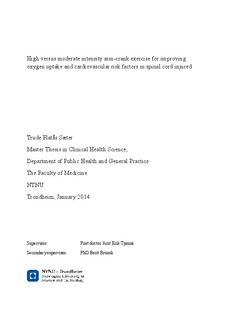| dc.description.abstract | Background/Aim: Spinal cord injury (SCI) is a debilitating condition which leads to loss of
sensory and/or motor function of varying degrees below the level of injury. Physical inactivity
is a major risk factor for developing cardiovascular disease and early death. Physical
inactivity is highly prevalent in SCI population. Maximal oxygen uptake is a predictor for
cardiovascular health. In studies with able-bodied, aerobic high intensity training has been
found superior compared to moderate intensity, in terms of increasing oxygen uptake and
reducing risk factors for CVD. Only a limited amount of studies have investigated the role of
intensity of training during arm-crank exercise (ACE) in terms of effect on aerobic capacity
and prevention of cardiovascular risk factors in individuals with a SCI. Therefore the primary
aim of this study was to compare the effect from high-intensity ACE (i.e. 85-95% of peak
heart rate) in 4 x 4 minute intervals, with isocaloric moderate intensity ACE (i.e.70% of peak
heart rate) on peak oxygen uptake for individuals with chronic traumatic SCI. Secondary
aims were to compare the effect from high- versus moderate intensity ACE on lipid profile,
fasting glucose, hypertension and resting heart rate. Methods: 10 traumatic SCI participants
volunteered for 8 weeks of ACE with 3 exercise bouts per week. The participants were
randomized into two groups, high intensity ACE (85-95%HRpeak
), (N=5), and moderate
intensity ACE (70 %HRpeak
), (N=5). A pre-test posttest design was used, and the participants
were tested for VO2peak
, lipid profile, insulin resistance, blood pressure and resting heart rate
at pre- and posttest. Results: No significant difference between the high- and moderate
intensity ACE in terms of VO2peak
was found. Although not significant there was a favorable
trend towards a higher increase in mean VO2peak
in the high intensity group compared to the
moderate intensity (high intensity group mean increase 8. 9% (l/min), while the moderate
intensity group had a minor mean decrease of 2. 1% (l/min)) No significant difference in the
blood glucose levels, blood pressure, lipid profile and resting heart rate was found between
the two groups after 8 weeks of ACE. Conclusions: No significant differences were found
between the high and moderate intensity groups after 8 weeks of ACE. Individual differences
affect our results. Our findings indicates that eight weeks of high intensity ACE may improve
the aerobic capacity for chronic SCI individuals more than moderate intensity ACE. The
cardiovascular risk factors such as the lipid profile seem to be improved by exercise for SCI
people, but we cannot say if the intensity is the dependent factor. | nb_NO |
